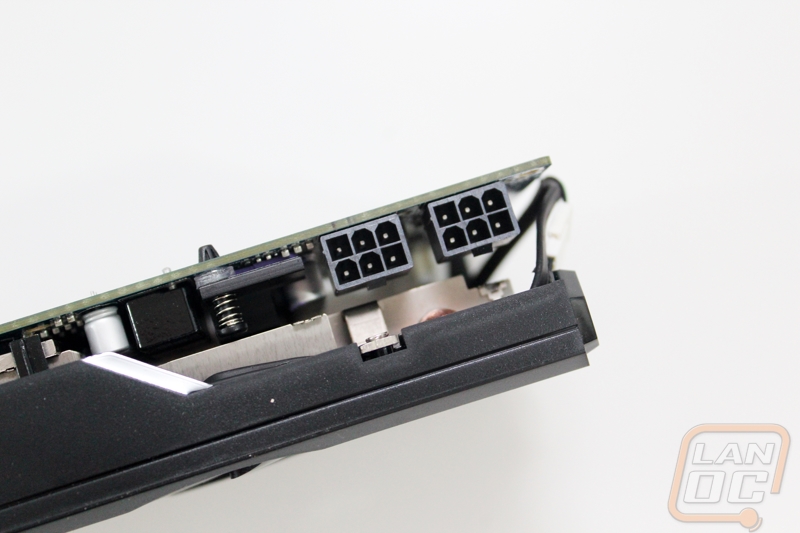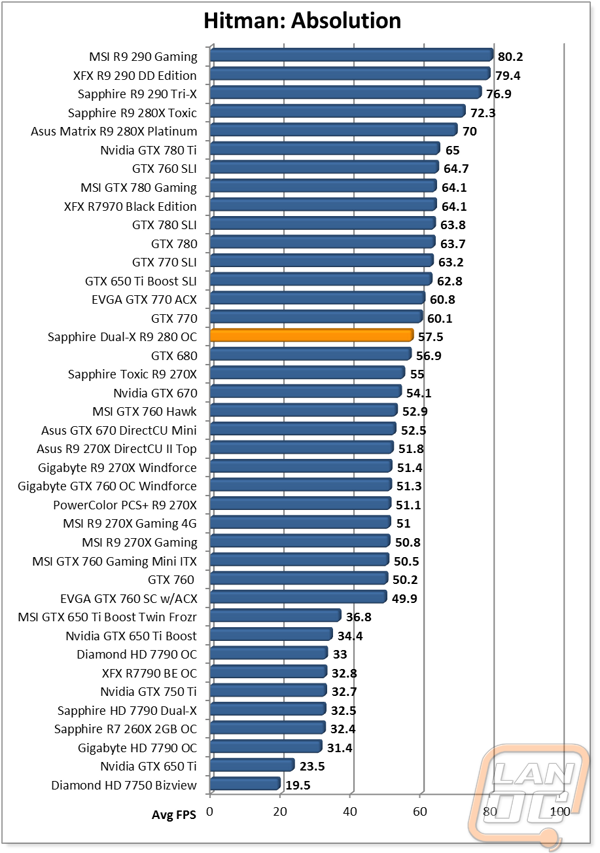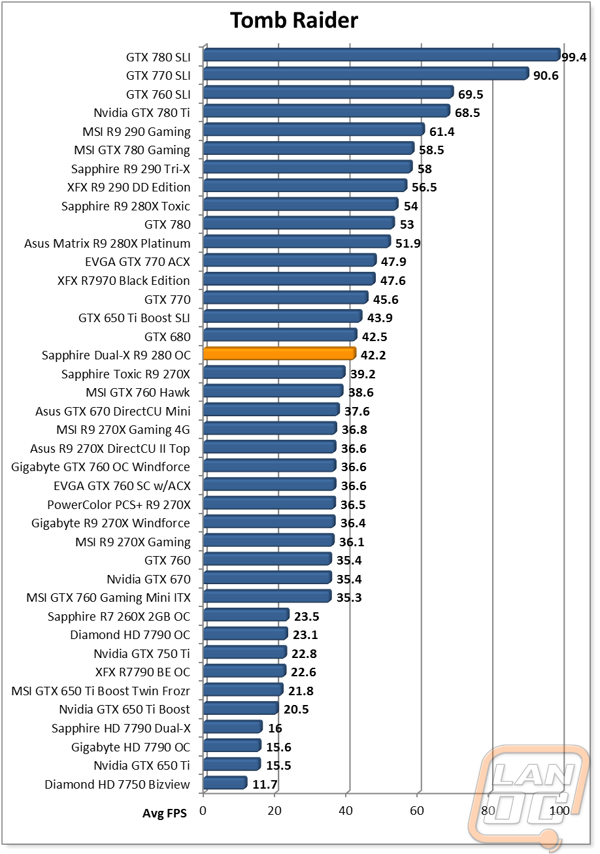As we get farther away from the initial launch of AMD’s lineup they have continued to fill in the blanks with a few other cards. One of those is the R9 280 that sits in between the R9 280X and the R9 270X. Sapphire sent over one of their overclocked models for me to check out. I have been extremely impressed with Sapphires product line this generation but this will be the first of their Dual-X cards to come in the office so I will reserve my judgment until we see how well it performs in our test suite.
Product Name: Sapphire Dual-X R9 280 OC
Review Sample Provided by: Sapphire
Written By: Wes
Pictures by: Wes
|
Specifications |
|
|
Display Support |
3 x Maximum Display Monitor(s) support |
|
Output |
1 x HDMI (with 3D) 1 x DisplayPort 1.2 1 x Dual-Link DVI-D 1 x Dual-Link DVI-I |
|
GPU |
850(Boost:940) MHz Core Clock 28 nm Chip 1792 x Stream Processors |
|
Video Memory |
3072 MB Size 384 -bit GDDR5 5000 MHz Effective |
|
Dimension |
262(L)X112(W)X34(H) mm Size. 2 x slot |
|
Software |
Driver CD SAPPHIRE TriXX Utility |
|
Accessory |
CrossFire™ Bridge Interconnect Cable 6 PIN to 4 PIN Power Cable x 2 |
Packaging
For this generation of cards Sapphire changed their packaging design to a more flashy design with colors that match the cooler design. Therefore, the orange boxes are for cards with the orange heatsinks like the Tri-X and the Toxic cards. The purple box that the Dual-X comes in is a little different, because the Dual-X is different from the Tri-X cards. Even so, the overall layout of the packaging is similar with the product name up in the top right corner, the sapphire logo on the left, and a a few features highlighted with icons along the bottom.

The back of the box continues the purple theme. Half of the back of the packaging has a marketing explanation of the Dual-X R9 280 while on the right side there are more icons highlighting features, this time those icons also have explanations next to them to give you a little more information.

Inside the box is a second box, on the outside of the box Sapphire has included a sticker with your model information and serial number. Inside the Dual-X R9 280 is wrapped up in a static protective bag that is made out of padded bubble wrap. The card sits in a tray to keep it from moving around. All of the accessories and papers can be found in yet another box down under everything. Here you will find a software/driver disc, information on registering your card, and a quick installation guide for documentation. For accessories, you get two Molex to six pin adapters for anyone who doesn’t have the power connections for the 280. You also get a standard crossfire bridge and Sapphire went out of the way to include an HDMI cable as well.




Card Layout and Photos
So for this year, most of the cards that I have seen from Sapphire have been their Tri-X cards with amazing cooling. With a name like Dual-X I think it’s obvious that this isn’t a triple fan design this time around. The Dual-X cooler design may have fewer fans but Sapphire did pack the largest fans they possibly could into the card. To do this the cooling design is actually taller than the PCB. The fan shroud design is a little less interesting than the other Sapphire cards with its silver and black design. That isn’t a big issue though, I think the silver and black shroud will go with more builds than the brighter colors.



As usual the aftermarket cooling design blows down over the heatsink where a reference design pushes air right to left to blow the air out the back of the card. This can be seen in the photos below. We can also see the heatpipes Sapphire used to pull the heat away from the GPU and out over the heatsink. The top bottom, and right side of the card are open aired meaning this card will push some warmed air into your case as well.


Just like with the 280X Toxic that I took a look at previously, the Dual-X R9 280 OC has the sapphire button up on the top edge next to the crossfire connections. This button turns on a UEFI BIOS that will give you faster boot and resume times when working with Windows 8 and motherboards that have UEFI BIOS’ as well.

For power connections, the Dual-X R9 280 OC requires two 6-pin connections to keep things running. This is in line with a reference 280; the R9 280X requires an 8-pin and a 6-pin. If you look, you can see where there is room for an 8-pin header due to this being the same PCB as the R9 280X.

For connections Sapphire stuck with the standard options with the Dual-X R9 280 OC. You get two DVI connections with one having the analog pass-through that is required for DVI to VGA adapters. You also get HDMI and DisplayPort connections, both being full sized.

On the flip side of the Dual-X R9 280 things are a little boring with the bright blue PCB. Those of you building a blue themed build won’t mind but in other builds the blue will stand out a lot compared to a nice flat black PCB that most people tend to favor.

Our Test Rig and Procedures
|
Our Test Rig |
|
|
CPU |
|
|
Memory |
|
|
Motherboard |
|
|
Cooling |
|
|
Power Supply |
|
|
Storage |
|
|
Case |
|
|
Our Testing Procedures |
|
|
Bioshock Infinite |
Using the Adrenaline Action Benchmark Tool we run Bioshock Infinite on the “Xtreme” quality setting. This has a resolution of 1920x1080, FXAA turned on, Ultra Texture detail, 16x Aniso Texture Filtering, Ultra Dynamic Shadows, Normal Postprocessing, Light Shafts on, Ambient Occlusion set to ultra, and the Level of Detail set to Ultra as well. |
|
Tomb Raider |
Using the Adrenaline Action Benchmark Tool we run Tomb Raider on the “Xtreme” quality setting. This has a resolution of 1920x1080, Exclusive Fullscreen turned on, Anti-Aliasing set to 2xSSAA, Texture Quality set to Ultra, Texture Aniso set to 16x Aniso, Hair Quality set to TressFX, Shadow set to Normal, Shadow Resolution on High, Ultra SSAO, Ultra Depth of Field, High Reflection quality, Ultra LOD scale, Post Processing On, High Precision RT turned on, and Tessellation is also turned on. |
|
Hitman: Absolution |
Using the Adrenaline Action Benchmark Tool we run Hitman: Absolution on the “Xtreme” quality setting other than the MSAA setting is turned down from 8x to 2x. That setting puts the resolution at 1920x1080, MSAA is set to 2x, Texture Quality is set to High, Texture Aniso is set to 16x, Shadows are on Ultra, SSA is set to high, Global Illumination is turned on, Reflections are set to High, FXAA is on, Level of Detail is set to Ultra, Depth of Field is high, Tessellation is turned on, and Bloom is set to normal. |
|
Sleeping Dogs |
Using the Adrenaline Action Benchmark Tool we run Sleeping Dogs on the “Xtreme” quality setting. That means our resolution is set to 1920x1080, Anti-Aliasing is set to Extreme, Texture Quality is set to High-Res, Shadow Quality is High, Shadow Filter is set to high, SSAO is set to High, Motion Blur Level is set to High, and World Density is set to Extreme. |
|
F1 2013 |
We use the built in benchmark for F1 2013. We set our resolution to 1920x1080 and then use the “Ultra” setting. |
|
Total War: Shogun 2 |
Direct X11 Benchmark High setting |
|
Crysis 2 |
Using Adrenaline Crysis 2 benchmark. 1080p, 4x Anti-Aliasing, DX11, Laplace Edge Detection Edge AA, on the Times Square map, with hi res textures turned on. |
|
Battlefield 3 |
Using Fraps with the game set to Ultra settings with 4x MSAA Antialiasing Deferred, 16X Anisotropic Filter, at 1920x1080. |
|
Sniper V2 Elite |
1920 x 1080 resolution, graphics detail set to ultra |
|
Dirt Showdown |
1920 x 1080 resolution, 4x MSAA multisampling, Vsync off, Shadows: ultra; Post Process: High; Night Lighting: High; Vehicle Reflections: Ultra; Ambient Occlusion: Ultra; Water: high; Objects: Ultra; Trees: Ultra; Crowd: Ultra; Ground Cover: High. |
|
Metro Last Light |
Using the included benchmark tool. The settings are set to 1920x1080, DirectX 11, quality is set to very high, Texture filtering is untouched at 4x, and motion blue is set to normal. SSAA is unselected, PhysX is unselected, Tessellation is off. We run through scene D6 three times to get an average score. |
|
Synthetic Benchmarks |
For video cards our synthetic benchmarks are limited to 3DMark Vantage 2011, and 3DMark 2013 (AKA 3DMark). In 3DMark Vantage 2011 we run both performance and extreme benchmarks. The same goes for the most current version of 3DMark, we run through Fire Strike on standard and extreme settings. |
|
Unreal Heaven Benchmark 4.0 |
Using the “Extreme” preset |
|
Unreal Heaven Benchmark 4.0 heat testing |
We run through Unreal Heaven at 1080p for 30 minutes to test in game heat performance and noise output of the card while under load. |
|
Power Usage |
Using Unreal Heaven Benchmark 4.0, we get our “load” power usage number from the peak power usage during our test. We get our numbers from a Kill-A-Watt connected to the test benches power cord. |
|
Noise Testing |
Our Noise testing is done using a decibel meter 3 inches away from the video card on the bottom/fan side of the card. We test an idle noise level and then to get an idea of how loud the card will get if it warms all the way up we also turn the fan speed up to 100% and test again. The 100% test isn’t a representation of typical in game noise levels, but it will show you how loud a card can be if you run it at its highest setting or if it gets very hot. |
Cooling, Noise, and Power
Considering most cards run a reference PCB or close to it, the cooling and noise performance of a card is where companies can really try to stand out with their aftermarket heatsink designs. Because of that this is always my favorite set of benchmarks to check out. The triple fan Sapphire cards have been doing very well in cooling performance and even with three fans the noise performance hasn’t been all that bad as well. Let’s see how well the 280 did with just two fans. But first, I ran the Dual-X though our power benchmarks. The idle power consumption wasn’t all that impressive, in fact I have to wonder if our driver wasn’t acting up a little but I did run through the test a few times to be sure with the same result. Under load however the numbers seemed to be a little closer to where they should be. The Dual-X R9 280 OC pulled noticeably less than the 280X’s that I have tested in the past. With being so close in design to the 280X’s it was still up closer to them than the 270X below it.

In the noise testing the Dual-X fell in the bottom half of our testing with its quiet performance. This was even more noticeable on the 50% fan speed tests. This test is a better representation of that to expect from every day usage.


So how well did the Dual-X cooler perform? Well as you can see below it actually tired with an R9 270X with an aftermarket cooler and came in cooler than the triple fan (and more powerful) cards.

Synthetic Benchmarks
Regulars to the site will notice that there are a few fewer tests in our synthetic benchmark suite. I cleaned out a few of our older tests now that we have been using the latest version of 3DMark Fire Strike for some time now. This should make it a little easier for you to check out the results without losing any unique information. So how did the Dual-X R9 280 OC perform? As expected, when compared to other AMD cards the 280 fell right in between the R9 270X and R9 280X. The 280 performance came a little close to the 270X than the 280X when it was all said and done but it still did well against its competition from Nvidia. Our fastest GTX 760 still came in slightly below in both regular and extreme benchmarks. In Unreal Heaven Benchmark 4.0 the GTX 760 did pull ahead slightly though with only the reference 760 below the overclocked 280.



In Game Benchmarks
As always, all of the other numbers are great, but when it comes down to it we buy nice video cards to play games. To see how well the Dual-X R9 280 OC will perform in actual games I ran through a variety of games to get an average FPS in each. That means you can expect to see higher and lower FPS, but this is around the average you should see. Out of the 11 games tested 7 of the average FPS were above 60, what most people considering to be a great framerate. One of the games, Metro Last light, was less than one FPS away from 60 with its 59.33 average. Most came in considerably higher though, like F1 2013 for example with an average of 122 FPS. The games that didn’t reach 60 FPS did all have what most consider playable frame rates with the lowest at a still respectable 44 FPS. While the Dual-X R9 280 OC didn’t top our charts, the end result is that you can expect to be able to play anything on the market right now with the settings turned up at 1080p, it isn’t until you start running higher resolutions, multiple monitors, or high refresh rate monitors that you will really need much more power to enjoy your games.











Overall and Final Verdict
With this being the first R9 280 that we have had the pleasure to take a look at. I am happy to finally confirm that you don’t have to go all out with an R9 280X or higher to enjoy the best of todays games. The Dual-X R9 280 OC plowed through our in game testing with great results making it a great choice for someone who is still on a limited budget and is gaming at 1080p. I wasn’t sure how well Sapphire’s cooling design would work with just the two fans compared to their Tri-X coolers but the lowered heat output of the 280 over the 280X helped keep this card running even cooler than the powerful 280X Toxic that I tested earlier this year.
One of the only complaints I had about the Dual-X R9 280 OC was with its rather bland styling. With its black and grey color scheme it isn’t as flashy as the other Sapphire cards from this generation. To some that will be a perk, because the orange or purple heatsinks might not go with every build, the grey will fit in much better. But with the inclusion of the bright blue PCB this card will still most likely look a little less stylish in most builds. Of course its performance makes up for that.
So we know how it performs but where does it land in the market price wise? Well this this is a little tricky. With AMD cards being nearly impossible to come by for the past six months their prizes have been all over the place. The reference MSRP of the R9 280 is $279 at launch and the R9 280X is $299. While the prices have been coming back down, the 280X is still a little more expensive, so the $299 that this card is selling for right now on Newegg isn’t a bad deal. But if 280X’s come back down to their MSRP soon, this card will be overpriced. Even if they sold it at the reference card MSRP of $279, I would rather throw down the $30 for the considerable jump in performance. The pricing right now is in no way Sapphires fault though, hopefully the market levels out and more people can start enjoying well priced cards for their gaming rigs!






